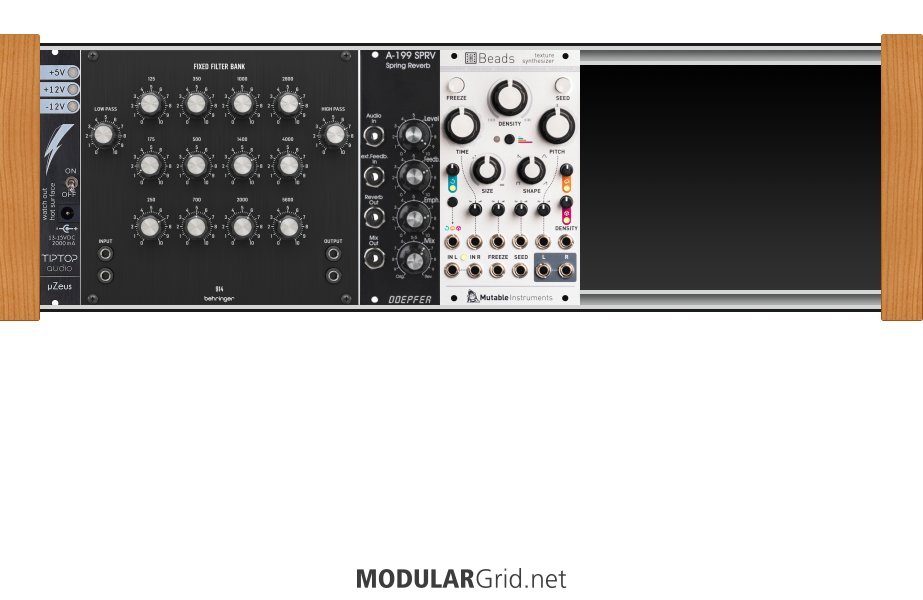+1 on bigger case. I'm 100% down with that here, especially if these big lunky modules are going to be the norm.
OK...let's get a few things about voltage levels explained. First of all, in the non-modular music gear world, you'll find two standards in use. One of these is the "consumer" line level, for which 0.775 Vrms = 0 dB. Then there's the hotter "pro" level, which comes out to 1.4 Vrms = 0 dB. Note that both of these are the audio levels; clock, gate, and triggers tend to always be 5V, no matter what...
EXCEPT...
That Korg. The Korg MS-series stuff (and its relations, such as the SQ-10 and VC-10) uses a "negative-going" gate/trigger scheme, sort of similar to the old Moog "S-Trig" bus but far less prone to voltage sag. So while you could use the MS-20 as an audio input, your ability to fully use the envelope follower in a way that the modular likes will be pretty compromised. The solution to that is something like G-Storm's KVP, which is a "translator" to/from normal synths to the Korg MS-environment's negative trigger/gates and Hz/V scaling.
See, in modular, there's still some debate as to whether the level for signals besides gate/trigger/clock should be 5 Vrms, 8 Vrms, or 10 Vrms, and then there's the major CV scaling difference, which assures that you can't effectively use an MS-20 (without conversion, natch) as a controller for a "standard" modular (unless, of course, your name is "Richard D. James" and you make use of the scaling mismatch to work in microtonal tunings). But that scaling issue is pervasive...the entire MS-verse is set up for that Hz/V scaling, from your VCO CVs to the modulation sources.
My suggestion is this: first of all, disconnect the spring tank from your mixer's send/return. The reason it sounds so quiet is because the audio levels IT wants to use are different. You need to feed it a 1.4 Vrms (or higher...depends on the tank) for its input, and then the output from the spring tank needs quite a bit of preamping as that's a raw signal right off of the (usually) piezo pickup on the springs...very LOW level signal! Also, there's probably some interesting impedance mismatching going on there as well.
Next, jettison the present build. It just isn't going to do what you think it should. For one thing, you have no way to bring your inputted audio up to the proper voltage level; something like a Doepfer A-119 is needed. Secondly, go back and study your dubplate stylee masters...King Tubby, for example, made extensive use of the highpass filter on his MCI JH-416 desk; a filter bank of this sort isn't quite the right device for the job, either musically or historically. I don't see the need for the wavetable VCO, either, especially in the absence of the rest of the synth it should be a part of. And the SOMA delay, while really cool, is huge...it REALLY doesn't fit this, and it'd be a real stretch to jam into even a 2 x 104 build. Instead, there's loads of delays that even have that right lo-fi BBD sound out there; you could strap together two of Noise Reap's Dub Delays, or use just one alongside an Alright Devices Chronoblob2...which is stereo and which also features the quasi-irresponsible bit of madness that is its insert point in the feedback path, which allows you to put something else in there to mess with how the delay deals with repeats. But really, the overall point is to conserve panel space while keeping the functionality as high as possible. The build above, aside of not really being set up to work, is lacking in functional density when you compare it to other builds.
Instead, look into a WAY larger case...at least, while building on here. The rationale is that you can overbuild FIRST, then strip this down gradually into a system that does what you want AND which is engineered to fit into the optimal necessary space. THEN select a cab to put the whole mess in and put the result together in hardware. Also, expect this to take a while...it's NOT the easiest process, building one of these modular thingummies, but you've got the best resources possible with Modulargrid.


